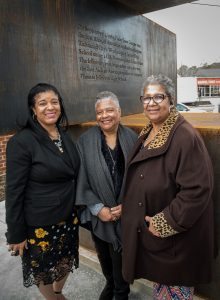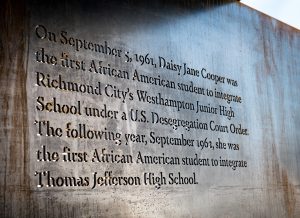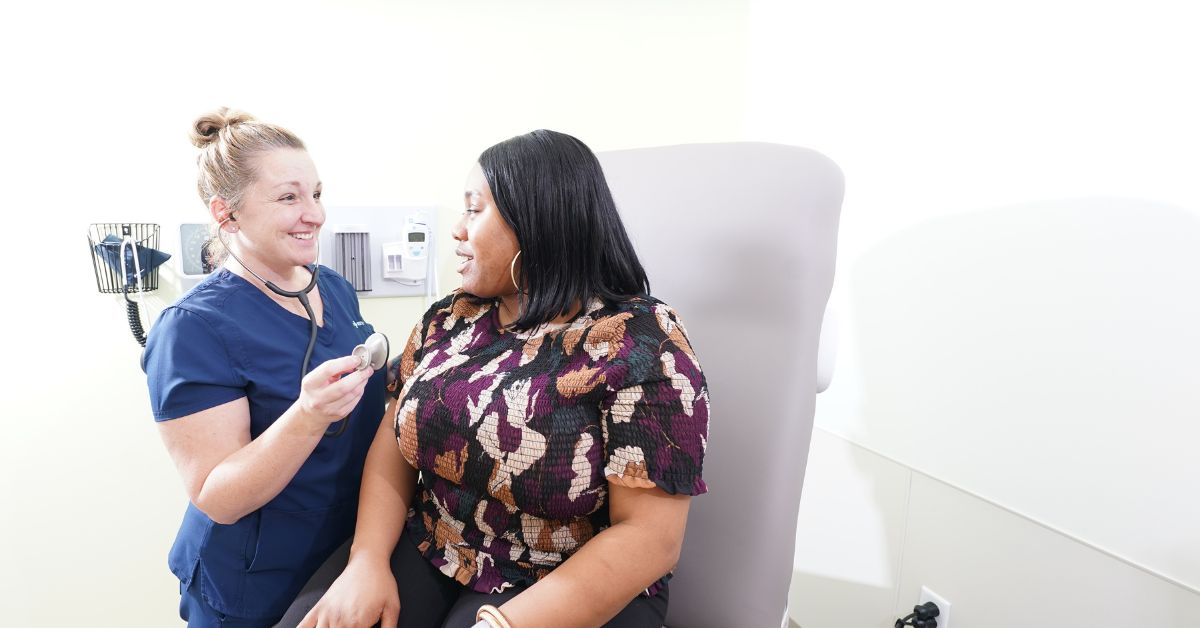As we commemorate Black History Month, we are reminded of the pivotal moments and courageous individuals who have shaped our collective narrative in the communities in which we serve.
One such momentous occasion occurred recently with the unveiling of a sculpture that stands as a testament to the enduring spirit of racial integration and the pursuit of educational equity. This sculpture, erected to honor Jane Cooper Johnson and her pivotal role in the integration movement in the City of Richmond, serves as a powerful symbol of progress and unity in the face of adversity.
Richmond’s newest sculpture, Strides, commemorating the racial integration of Westhampton Junior High School and Daisy Jane Cooper’s place in Richmond’s history, was unveiled on Jan. 30,, 2024.

Standing 12 feet tall at the corner of Patterson and Libbie Avenues, Strides was designed to inspire viewers to consider the weight of mounting pressures that Daisy must have felt when, in 1961 after a three-year legal case and a U.S. District Court order to desegregate, she became the first African American student at Westhampton at just 12 years old.
Daisy Jane Cooper, today known as Jane Cooper Johnson, was just 9 years old when her mother, Elizabeth Cooper, decided she wanted an equal opportunity education for her daughter. Their family lived on Marian Street in the current Westwood Historic Neighborhood, which is bordered by Willow Lawn Drive and Patterson Avenue. It was four-and-a-half blocks to the all-white Westhampton Elementary School, but Daisy Jane and all the children of color in her African American neighborhood were bused five miles away to the all-Black George Washington Carver Elementary School.
In 1958, years after the U.S. Supreme Court’s 1954 Brown v. Board of Education ruling for school desegregation, Elizabeth Cooper took action. An application was filed on her behalf to transfer her daughter Daisy Jane to Westhampton Elementary School. Two other plaintiffs joined Mrs. Cooper in her request. Attorney Oliver Hill and fellow NAACP lawyers represented the case, which continued over a three-year period.
Then, in July of 1961, Daisy Jane Cooper was granted admission to Westhampton Junior High School.
It was granted under a U.S. desegregation court order that was handed down by Judge Oren R. Lewis, U.S. District Court of the Eastern District of Virginia. On the first day of school in September of 1961, 12-year-old Daisy Jane walked to school, with her mother, Elizabeth, and Dr. Wendell P. Russell, pastor at Westwood Baptist Church and dean of students at Virginia Union University, by her side. A year later, she walked into Richmond’s Thomas Jefferson High School alone, becoming the first African American student to integrate that school as well.
“People often tell me that I was very brave,” Jane Cooper Johnson shared in an interview with the Richmond Times-Dispatch in 2018. “Well, that may be the case, but the foremost example of resilience can be credited to my mother. Yes, my mother was resolute in wanting the best for me, despite any obstacles before her. However, because of her courage, and my being a product of my environment, I, too, was able to withstand the challenges ahead.”
About Strides

Strides, aptly named to honor those first courageous steps Jane Cooper Johnson took on the steps leading to the Westhampton School in 1961, consists of two 12-foot by 6-foot forms. Standing four feet apart, the two mirrored forms create negative space between them in the shape of a plus sign, which serves as a visual symbol of integration. By entering and moving through this negative space, one can sense tension from the close proximity of surrounding forces. This exercise is meant to inspire viewers to consider what Ms. Cooper Johnson must have felt that first day of school, with the weight of mounting pressures all around her.
Emerge from the interior, walk around the sculpture to either end and one can see that Strides is, in essence, two plus signs consolidated into one experience. This is the story of integration: the joining of many for the strength of all.
Esteemed sculptor Paul DiPasquale assisted our ministry, Thalhimer and a committee made up of members of the community to solicit submissions from the local arts community. Ultimately, the Strides proposal submitted by local artist Matt Lively and Tim Harper of Lively Harper Environmental Sculpture was selected.
Racial integration at Bon Secours St. Mary’s Hospital

Our ministry has a unique tie to this history. Not only does Bon Secours St. Mary’s Hospital neighbor the historic site where the Westhampton School stood, but when Bon Secours opened St. Mary’s Hospital in 1966, it was the first racially integrated hospital in Richmond.
Back then, it was typical of hospitals and other public buildings in the South to have segregated restrooms, patient rooms, waiting rooms and much more. When Mother Germanus, one of the Sisters of Bon Secours who founded the hospital, had her first glimpse of the architectural drawings for the new hospital, she took a bold stand and refused to allow the hospital to be segregated.
She tore up the architects’ plans and influenced the presiding Bishop to align with the Sisters’ insistence that St. Mary’s would be the region’s first integrated hospital, several years after the integration of Westhampton School. Much like Jane Cooper Johnson, St. Mary’s Hospital became instrumental in showing that integration could work when people and organizations are guided by values that honor human dignity, equality and justice.
“At Bon Secours, we have long valued human dignity, diversity, equity and inclusion as ministry priorities,” Drew Burrichter, vice president of Mission in our Richmond market, shares. “Our Mission calls us to improve the health and well-being of our communities and bring good help to those in need and continue on the legacy of the Sisters who committed to serving everyone without regard to race, religion or ability to pay when they first answered the call to serve 200 years ago in Paris, France.”
For every courageous stride taken by young Daisy Jane, we are eternally grateful. Through her extraordinary faith, humanity and strength of character, she raised awareness of injustices and raised expectations and hopes for a more inclusive and just society.
And today, she continues to build bridges and forge new paths paved with friendship and understanding, inviting others to join and work together with her to make our diverse community a healthier, more equitable and more peaceful place for all.
Learn more about our Mission at Bon Secours.





